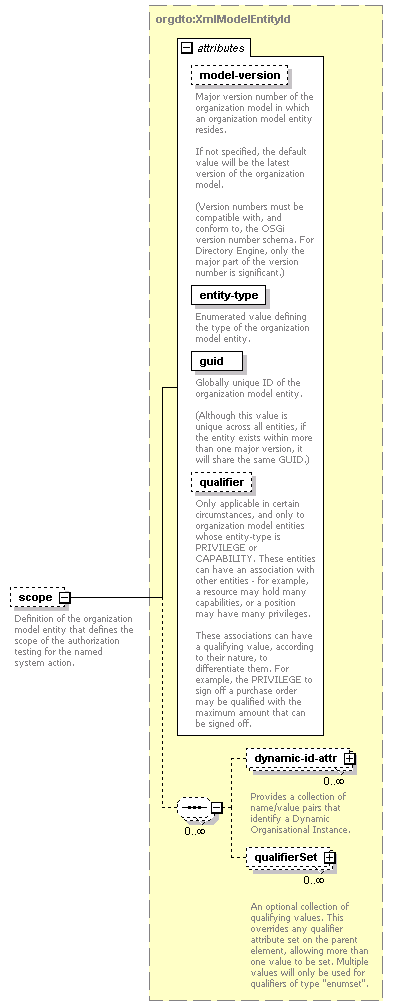| diagram |  |
||||||||||||||
| namespace | http://security.api.de.n2.tibco.com | ||||||||||||||
| properties |
|
||||||||||||||
| children | scope action | ||||||||||||||
| attributes |
|
||||||||||||||
| annotation |
|
||||||||||||||
| source | <xs:element name="isActionAuthorisedResponse"> <xs:annotation> <xs:documentation>Response element for isActionAuthorised operation.</xs:documentation> </xs:annotation> <xs:complexType> <xs:sequence> <xs:element name="scope" type="orgdto:XmlModelEntityId" minOccurs="0"> <xs:annotation> <xs:documentation>Definition of the organization model entity that defines the scope of the authorization testing for the named system action.</xs:documentation> </xs:annotation> </xs:element> <xs:element name="action" maxOccurs="unbounded"> <xs:annotation> <xs:documentation>Definition of a system action and whether the user is authorized to perform it.</xs:documentation> </xs:annotation> <xs:complexType> <xs:complexContent> <xs:extension base="XmlSystemAction"> <xs:attribute name="authorised" type="xs:boolean"> <xs:annotation> <xs:documentation>Boolean value indicating whether the user specified in the request: - has the necessary privileges to perform the named system action (TRUE). - does not have the necessary privileges to perform the named system action (FALSE).</xs:documentation> </xs:annotation> </xs:attribute> </xs:extension> </xs:complexContent> </xs:complexType> </xs:element> </xs:sequence> <xs:attribute name="overall" type="xs:boolean"> <xs:annotation> <xs:documentation>Boolean value indicating whether the user specified in the request is: - authorized to perform all of the requested system actions (TRUE). - authorized to perform only some, or none, of the requested system actions (FALSE).</xs:documentation> </xs:annotation> </xs:attribute> </xs:complexType> </xs:element> |
attribute isActionAuthorisedResponse/@overall
| type | xs:boolean | ||
| annotation |
|
||
| source | <xs:attribute name="overall" type="xs:boolean"> <xs:annotation> <xs:documentation>Boolean value indicating whether the user specified in the request is: - authorized to perform all of the requested system actions (TRUE). - authorized to perform only some, or none, of the requested system actions (FALSE).</xs:documentation> </xs:annotation> </xs:attribute> |
element isActionAuthorisedResponse/scope
| diagram |  |
||||||||||||||||||||||||||||||||||||||
| type | XmlModelEntityId | ||||||||||||||||||||||||||||||||||||||
| properties |
|
||||||||||||||||||||||||||||||||||||||
| children | dynamic-id-attr qualifierSet | ||||||||||||||||||||||||||||||||||||||
| attributes |
|
||||||||||||||||||||||||||||||||||||||
| annotation |
|
||||||||||||||||||||||||||||||||||||||
| source | <xs:element name="scope" type="orgdto:XmlModelEntityId" minOccurs="0"> <xs:annotation> <xs:documentation>Definition of the organization model entity that defines the scope of the authorization testing for the named system action.</xs:documentation> </xs:annotation> </xs:element> |
element isActionAuthorisedResponse/action
| diagram |  |
||||||||||||||||||||||||||||||
| type | extension of XmlSystemAction | ||||||||||||||||||||||||||||||
| properties |
|
||||||||||||||||||||||||||||||
| attributes |
|
||||||||||||||||||||||||||||||
| annotation |
|
||||||||||||||||||||||||||||||
| source | <xs:element name="action" maxOccurs="unbounded"> <xs:annotation> <xs:documentation>Definition of a system action and whether the user is authorized to perform it.</xs:documentation> </xs:annotation> <xs:complexType> <xs:complexContent> <xs:extension base="XmlSystemAction"> <xs:attribute name="authorised" type="xs:boolean"> <xs:annotation> <xs:documentation>Boolean value indicating whether the user specified in the request: - has the necessary privileges to perform the named system action (TRUE). - does not have the necessary privileges to perform the named system action (FALSE).</xs:documentation> </xs:annotation> </xs:attribute> </xs:extension> </xs:complexContent> </xs:complexType> </xs:element> |
attribute isActionAuthorisedResponse/action/@authorised
| type | xs:boolean | ||
| annotation |
|
||
| source | <xs:attribute name="authorised" type="xs:boolean"> <xs:annotation> <xs:documentation>Boolean value indicating whether the user specified in the request: - has the necessary privileges to perform the named system action (TRUE). - does not have the necessary privileges to perform the named system action (FALSE).</xs:documentation> </xs:annotation> </xs:attribute> |
XML Schema documentation generated by XMLSpy Schema Editor http://www.altova.com/xmlspy